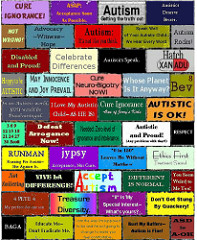So there I was mulling over how to approach long division with one of my seventh-grade students. There are several difficulties involved in his learning of the process, and I’ve only identified a few of them. One thing I do know for sure is that he has a low frustration threshold, and that mathematics is neither an easy nor an interesting subject for him. (Last week he had a meltdown after just a few problems and wouldn’t do any work for the rest of the hour.)
I thought back to yesterday’s class. A large part of the problem is that he doesn’t have his multiplication facts memorized. This could be from problems with rote memorization, and it could be also from problems with retrieval of information he already knows. Either or both gives the same result behaviorally. I have to be able to sift through what I observe and what he says, to determine what’s happening. After watching him remember most of what we went over the previous day, and watching him have to stop and calculate 22 minus 18, I suspected that it’s probably more of a rote memorization issue than a recall problem.
He also needed a more efficient method of calculating. I showed him that instead of going through the whole rote process of subtracting 8 from 12 by borrowing the 1 from the tens column, he could count from 18 to 22, and (looking at his fingers) see that there’s a difference of four. That sped up his working pace and reduced the cognitive load. It also helped him see that subtracting is finding the distance between two amounts, rather than just cranking through stacks of numerals.
He can calculate his multiplication facts (every single time he needs one) because he understands them as adding by multiples, and he figures the product by adding, “4 …. 8 …. 12 … 16” with each group of four on one finger, then look at his fingers and know that 4 times 4 is 16. Doing all this arithmetic with every step (such as figuring out how many 6’s are close to 37 for the first value of the quotient) places heavy demands upon working memory, and thus reduces his ability to learn and recall the larger process. All that work makes it hard to keep the data in short-term memory, and without that, it never makes it to long-term memory.
So a couple of days ago I brought out a multiplication table, but he didn’t understand it. Time to backtrack and get a better grip on multiplication! I got some manipulative cubes, and we built up a partial table, setting up 2 sets of 3. He counted each cube, “That makes six,” and then 3 sets of 2, “That also makes six,” and he wrote 6’s in both squares. We went over 3×4 and 4×3, and he wrote 12’s in both squares. Ah-ha! The order you multiply doesn’t matter. “That’s called the Commutative Law,” I explained. “It doesn’t matter if you multiply 4×5 or 5×4, whatever order you multiply them, you still get 20. That means you only have to learn HALF of the multiplication table!” Then we went over 3×3 and 4×4 and 5×5 and learned why a number multiplied times itself is called a square – the blocks stacked up into squares. Finally he understood how the multiplication table is built and what he can do with it, so we decided to use it in his long division problems.
Sequencing is definitely a difficulty; he’s having problems remembering when he’s dividing and when he’s subtracting. He’s also getting confused on whether to put a number down as part of the quotient or as a product. That could also be a spatial processing issue. Some of our students have problems with their columns of numbers wandering about, which plays extra havoc when they get to decimals (I liken it to “getting decimated”), so I have them turn lined paper sideways and write their numbers in the columns between the lines.
One thing I had noticed yesterday was that he could describe the process to me verbally more easily than he could write the problem. He might very well be an auditory learner. This might also be a fine motor coördination issue (he writes his numeral 4 with three separate strokes) so we’ve been doing the problems with a whiteboard and marker. This makes it easier to write the problems down and also erase errors, in contrast to doing them with pencil and paper. The marker glides more easily, and the numerals are naturally larger. It’s also easier for me to see what he’s doing without breathing down his neck, which is more comfortable for both of us.
Today I started him out by asking him what his favorite sport is. Yes, that’s an odd way to start math class, and there was a few seconds of delay before he answered, “Baseball.” Tying the subject to his special interest makes it more interesting and relevant, and thus be more likely to “stick”. Starting with something that he likes also helps reduce his aversion to the subject. In this case, we needed to learn the names of the different parts of the division equation. Previously he’d been telling me to, “Put the 2 over the 3,” but knowing how to do one problem by rote process doesn’t always help when you get to a different kind of problem. He also needs to be able to understand that all the problems are built of the same types of pieces. So I explained that just as baseball teams all had the same kinds of positions (catchers, pitchers, basemen, outfielders and so on), so did division problems (divisor, dividend, quotient, product and remainder). Just as each team has different people playing those positions, different problems had different numbers playing different positions. Well, that made sense.
With this base of understanding, we began reviewing the process he’d mastered yesterday. Because of his low frustration tolerance, I wanted to be especially sure of emphasizing his achievement. Then we did four problems together, with me correcting errors and also doing the scribing. Having refreshed the process, for the second quartet of problems I had him tell me what do write, and he was nearly soloing. For the third quartet I had him tell me what he’s doing, and he did the writing as well. Then after all that achievement, we looked at the two different ways of writing the same problem, with the bracket or the dotted sign.
Of course, the big questions are whether or not today’s understanding made it into his long-term memory (if he can retrieve that process after a day or a weekend or a month), and if he understood what it is actually about.
Tomorrow we’ll go over again what a division problem means. 295 divided by 36 describes, “How many sets of 36 can we make from 295? Do we have any left over, or does it come out even?” I’ll also have him describe to me the overall process of long division, which I will type up for him to keep. Having the student explain something in their own words requires a higher taxonomic level of learning than just shuffling around a bunch of numbers. Using verbal description also ties the learning to another part of the memory.
The problem with learning rote processes without conceptual understanding is that the students will then stumble in pre-algebra. They will need to use abstract reasoning to evaluate which method to use when. Part of that abstract reasoning simply comes from the maturation of the brain, and part of it comes from creating that deeper understanding of different methods.
I can sympathize with our students’ mathematical difficulties. It took me four years to learn my multiplication tables, and even in statistics and calculus I still have pauses in recall. (Calculus concepts are a breeze, but I can’t memorize a formula to save my life.) I had also flunked a number of math tests when attending this very same school building, and now here I was teaching it to students. (The irony!) But I take that understanding of the frustration with me every day, and express it as patience. I apply everything I have learned (and continue to learn) about cognition and learning, and everything I have learned about observing people, and put them together in my work as a paraprofessional and as a college tutor.
All told, this student successfully completed 13 long division problems today. The whole process is making much more sense, and he persevered with the work through most of the class period. I told him that since he’d stuck with it so well (even when he got a bit frustrated) he could take a break for the last ten minutes of class. He commented that it was kind of fun. “Yup,” I agreed, “Math is like games or puzzles once you understand the process!” This is a good sign. It may not last – one good day after unknown months of difficulties isn’t enough to turn around a student, but it is part of a good start with a new teaching relationship.








Special education Blog Digest - Dividing We Stand said,
26 October 2006 at 6:08
[…] I thought back to yesterday?s class. A large part of the problem is that he doesn?t have his multiplication facts memorized. … Posted by qw88nb88I think it’s very interestingLink to original article […]
Tutoring Blog Digest - Dividing We Stand said,
26 October 2006 at 5:51
[…] I thought back to yesterday?s class. A large part of the problem is that he doesn?t have his multiplication facts memorized. … Posted by qw88nb88Thank you for interesting postLink to original article […]
mumkeepingsane said,
19 October 2006 at 6:18
Wow, so much hard work and it sounds like it’s paying off.
I could never multiply proficiently. I have no idea why. I still can’t. Hopefully someone else will be teaching my children these concepts or we’ll all be hopelessly lost (and asking daddy what 7*8 is *grin*).
qw88nb88 said,
19 October 2006 at 6:05
Why, they’re figurative fingers, of course! (grin)
My brain doesn’t use fingers, but a different set of visual/tactile increments. I never could multiply anything beyond single digit numbers in my head.
Justthisguy said,
19 October 2006 at 1:25
I hate to say this, remembering that I passed the math courses up through Diffy-queue, but I had to visulalize 22 and 18 on virtual fingers to give an answer to that problem. Ow!
Yes, I know nobody has that many fingers, I have my own modular weird system!